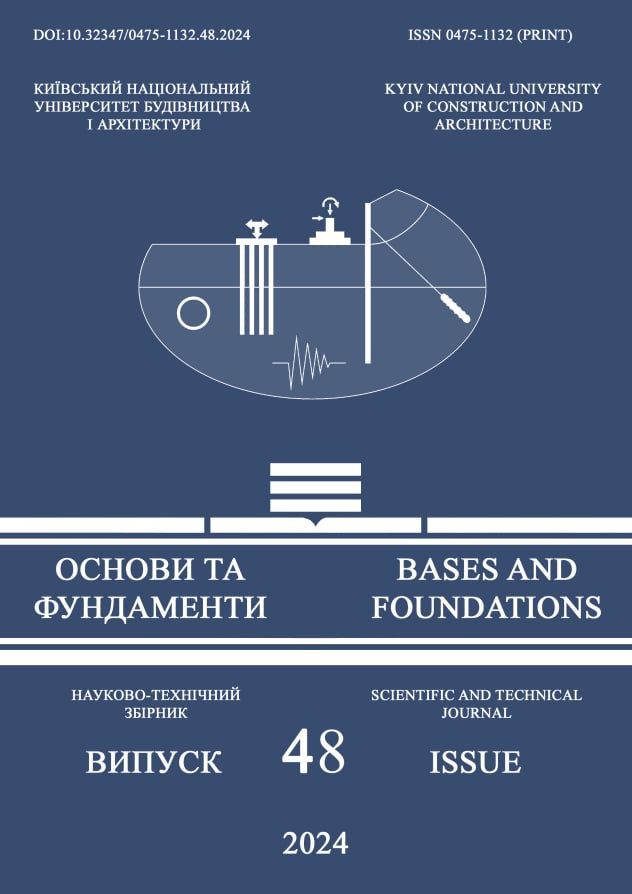Інтерпретації даних сучасних методів польових досліджень ґрунтів
Основний зміст сторінки статті
Анотація
Розглянуто сучасні методи польових випробувань ґрунтів. Досліджено вплив інтерпретації методів польових випробувань на розрахункові міцнісні та деформативні параметри ґрунтів та виконано порівняння з табличними значеннями за ДСТУ;
Сучасне проектування передбачає створення складних геотехнічних моделей при розрахунку взаємодії між основою і конструкціями споруди, що в свою чергу вимагає точних та оперативних досліджень ґрунтів, що є ключовим фактором у проектуванні та будівництві. Лабораторні методи, хоча і дають можливість безпосередньо визначити потрібні параметри, часто вимагають значних витрат часу та ресурсів. Перевага польових методів полягає в тому, що випробування виконується безпосередньо в масиві ґрунту, тобто на результат не впливає транспортування та підготовка зразків до випробувань. Проведення досліджень безпосередньо в масиві надає можливість отримати інформацію про характеристики ґрунтів та їх класифікацію, тобто дає інформацію про нашарування ґрунтів.
У даній публікації розглядаються сучасні методи польових досліджень ґрунтів, зокрема CPTu (Cone Penetration Test аналог статичного зондування ґрунтів) та DMT (Dilatometer Test або дилатометричний тест) [1, 2]. Ці методи широко застосовуються в Європі, тоді як для України вони є відносно новими і лише починають набувати популярності. Тому актуально порівняти параметри ґрунтів, які отримані на основі випробувань цими методами з табличними значеннями, що традиційно використовуються в Україні.
Порівняно значення деформацій та напружень за трьома розрахунковими моделями, що виконані за даними CPTu, DMT та ДСТУ. Зроблено порівняльний аналіз деформацій фундаментної плити при використанні моделей з пружним і пружно-пластичним середовищем.
Для цього було запроектовано фундаментну плиту та розроблено скінчено-елементну модель будинку досліджуваного фундаменту на масиві ґрунту з похилим нашаруванням ґрунтів, використанні моделі з пружним і пружно-пластичним середовищем
Блок інформації про статтю

Ця робота ліцензується відповідно до Creative Commons Attribution 4.0 International License.
Автори, які публікуються у цьому журналі, погоджуються з наступними умовами: Автори залишають за собою право на авторство своєї роботи та передають журналу право першої публікації цієї роботи на умовах ліцензії Creative Commons Attribution License, котра дозволяє іншим особам вільно розповсюджувати опубліковану роботу з обов'язковим посиланням на авторів оригінальної роботи та першу публікацію роботи у цьому журналі. Автори мають право укладати самостійні додаткові угоди щодо неексклюзивного розповсюдження роботи у тому вигляді, в якому вона була опублікована цим журналом (наприклад, розміщувати роботу в електронному сховищі установи або публікувати у складі монографії), за умови збереження посилання на першу публікацію роботи у цьому журналі. Політика журналу дозволяє і заохочує розміщення авторами в мережі Інтернет (наприклад, у сховищах установ або на особистих веб-сайтах) рукопису роботи, як до подання цього рукопису до редакції, так і під час його редакційного опрацювання, оскільки це сприяє виникненню продуктивної наукової дискусії та позитивно позначається на оперативності та динаміці цитування опублікованої роботи (див. The Effect of Open Access).Посилання
Młynarek Z. The Use of CPTU and DMT Methods to Determine Soil Deformation Moduli - Perspectives and Limitations / Z. Młynarek T. Lunne, J. Wierzbicki // Studia Geotechnica et Mechanica - Zialona Gora: UZ. – 2023. – 45(s1). p. 1-29. doi:10.2478/sgem-2023-0021.
Marchetti S. The Flat Dilatometer Test (DMT) in Soil Investigations / S. Marchetti, P. Monaco, G. Totani, M. Calabrese. – University of L'Aquila, Italy, 2001. – 41 с.
Szajna W. Wykorzystanie badań CPTu do wyznaczania parametrów gruntu w analizie stateczności skarp głębokich wykopów. / W. Szajna // Zeszyty Naukowe. Inżynieria Środowiska – Zielona góra: UZ. – 2010. – 139(19). – p. 93-104
Lunne T. Cone Penetration Testing in Geotechnical Practice / T. Lunne, P.K. Robertson, J.J.M. Powell. – Blackie Academic/Chapman & Hall, E&FN Spon, 1997. – 312 с.
Robertson, P.K. Void Ratio Redistribution in Undrained Triaxial Extension Tests on Ottawa Sand. / P.K. Robertson, A. Ayoubian // Canadian Geotechnical Journal – 1997. – Vol. 35(2). – p 351-359
Lingwanda M.I. Comparison of geotechnical uncertainties linked to different soil characterization methods. / M.I. Lingwanda, A. Prästings, S. Larsson, D. L. Nyaoro // Geomechanics and Geoengineering – 2017. – Vol. 12. – p 137-151.
Robertson, P.K. Interpretation of the Cone Penetrometer Test, Part II: Clay. / P. K. Robertson, R.G. Campanella // Canadian Geotechnical Journal –1983. – Vol. 20(4). – p. 734-745.
Ameratunga J. Correlations of Soil and Rock Properties in Geotechnical Engineering / J. Ameratunga, N. Sivakugan, B.M. Das. – Springer New Delhi – 228 с. doi:10.1007/978-81-322-2629-1
Labuz J.F. Mohr–Coulomb Failure Criterion. / J. F. Labuz, A Zang // Rock Mechanics and Rock Engineering. – 2012. – Vol. 45(6). – p 975–979 doi:10.1007/s00603‐012‐0281‐7
Основи та фундаменти споруд. Зміна № 1: ДБН В.2.1–10–2009. – [Чинний від 2011–07–01]. – К.: Мінрегіонбуд України, 2011. – 55с.
Młynarek Z., Lunne T., Wierzbicki J (2023). The Use of CPTU and DMT Methods to Determine Soil Deformation Moduli—Perspectives and Limitations. Studia Geotechnica et Mechanica 45(s1), 1-29. doi:10.2478/sgem-2023-0021.
Marchetti S., Monaco P., Totani G., Calabrese. M. (2001) The Flat Dilatometer Test (DMT) in Soil Investigations. University of L'Aquila, Italy, 41.
Szajna W. (2010). Wykorzystanie badań CPTu do wyznaczania parametrów gruntu w analizie stateczności skarp głębokich wykopów.[ Application of CPT in determination of soil parameters in slope stability analysis of deep excavations] Zeszyty Naukowe. Inżynieria Środowiska, Zielona góra: UZ, 139(19), 93-104. (in Poland)
Lunne T., Robertson P.K., Powell J.J.M. (1997). Cone Penetration Testing in Geotechnical Practice. Blackie Academic, Chapman Hall, London, 312.
Robertson P.K, Ayoubian A. (1997) Void Ratio Redistribution in Undrained Triaxial Extension Tests on Ottawa Sand. Canadian Geotechnical Journal, 35(2), 351-359
Lingwanda M.I., Prästings A., Larsson S., Nyaoro D. L. (2017) Comparison of geotechnical uncertainties linked to different soil characterization methods. Geomechanics and Geoengineering, 12, 137-151.
Robertson, P.K., Campanella, R.G. (1983). Interpretation of the Cone Penetrom-eter Test, Part II: Clay. Canadian Geotech-nical Journal, 20(4), 734–745.
Ameratunga, J., Sivakugan, N., Das, B.M. (2016). Correlations of Soil and Rock Prop-erties in Geotechnical Engineering. Devel-opments in Geotechnical Engineering. New Delchi: Springer New Delhi, 228. doi:10.1007/978-81-322-2629-1
Labuz, J.F., Zang, A. (2012). Mohr–Coulomb Failure Criterion. Rock Mechanics and Rock Engineering, 45(6), 975–979.
Osnovy ta fundamenty sporud. Zmina 1: DBN V.2.1–10–2009. (2011). Kyiv: Minregionbud Ukrayiny, 55 (in Ukrainian).
